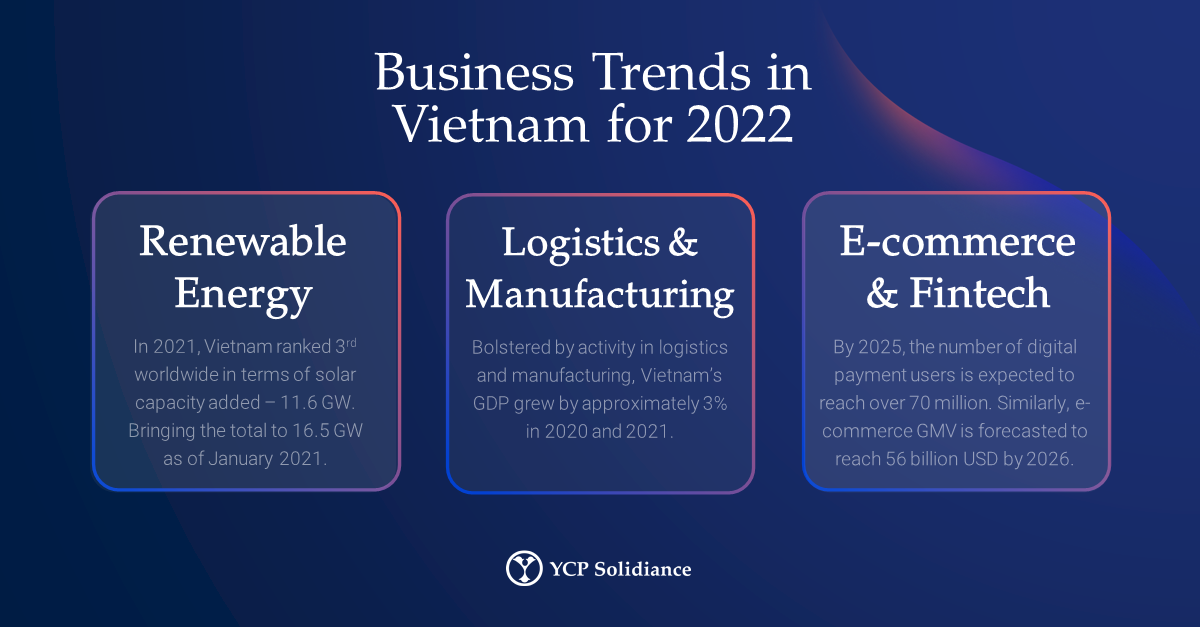What should businesses and professionals in Vietnam expect in 2022? As part of a new insight series, YCP Solidiance will be releasing several in-depth articles that feature emerging business trends in Vietnam, guided by research and analysis from YCP Solidiance Director, Dennis Lien.
Read the first installment below to get an overview of which industries and markets are expected to trend in Vietnam in 2022. To read future installments of this insight series, subscribe to our newsletter here.
As a result of Vietnam’s effective early COVID response during the onset of the pandemic, the economy performed relatively well largely due to the manufacturing industry’s ability to sustain operations and only brief and minor interruptions to business. In fact, Vietnam’s GDP grew by 2.91% in 2020 and then 2.58% in 2021 as per data from Trading Economics.
These numbers do not only indicate that businesses managed to develop amid the pandemic, but more importantly, it reflects that the progress achieved in 2020 and 2021 will likely carry over into which market and business trends will emerge in 2022.

Continued Interest in Renewables
One such industry that is continuing to garner major interest in Vietnam is renewable energy. This interest can be attributed to the unprecedented growth that the renewable energy industry has achieved over the past few years – particularly, in solar and wind energy.
According to a June 2021 industry report by REN21, Vietnam ranked 3rd worldwide in terms of solar capacity added with 11.6 GW, behind only the United States and China. Additionally, a separate report by the Institute for Energy Economics and Financial Analysis (IEEFA) determined that 16.5 GW solar capacity as of January 2021.
As per VN Express International, Vietnam is also investing heavily in wind energy as the latest draft of the Power Development Master Plan VIII aims to increase offshore wind power capacity to 36 GW by 2045.
Bolstered by Logistics and Manufacturing
Despite the delays caused by the persistence of supply chain issues, like the zero-Covid policy of China, the logistics and manufacturing industry of Vietnam remains in a promising position. Specifically, in 2022, Vietnam is expected to continue to leverage its advantageous geographic location, large population, and potential additions to the labor market (low-skilled and mid-skilled).
Such factors position Vietnam as an appealing option for investors, both internationally and domestically. This inevitably entails that the logistics and manufacturing industry will need to further develop specific areas to accommodate increased demand, such as cold chain logistics in the context of vaccination or storage, or even improved coordination between facilities and ports.
In addition, expect manufacturers to invest heavily in the fourth industrial revolution (4IR) as the technology available (cloud-based applications, robotics, IoT, etc.) and its application to traditional manufacturing processes could provide several benefits, such as automation of operations to help ensure supply chain resiliency.
The Emergence of E-commerce & Fintech
Given that e-commerce and fintech are complementary to the growth of other industries, and that these markets are still developing themselves, it is expected that these industries will continue to influence emerging business trends in 2022.
Further emphasis should also be given to the pervasive nature of both e-commerce and fintech as well, especially when considering that businesses in these industries can cater to individuals existing in several demographics. For example, fintech platforms that operate in cryptocurrency trading have witnessed increased activity among youth and young professionals.
As such, expect businesses in e-commerce and fintech to invest heavily into product development and related channels in the coming year so that both industries can fully capitalize on their popularity.
To explore further insights regarding relevant business trends all throughout Asia, subscribe to our newsletter and read these relevant reports:






